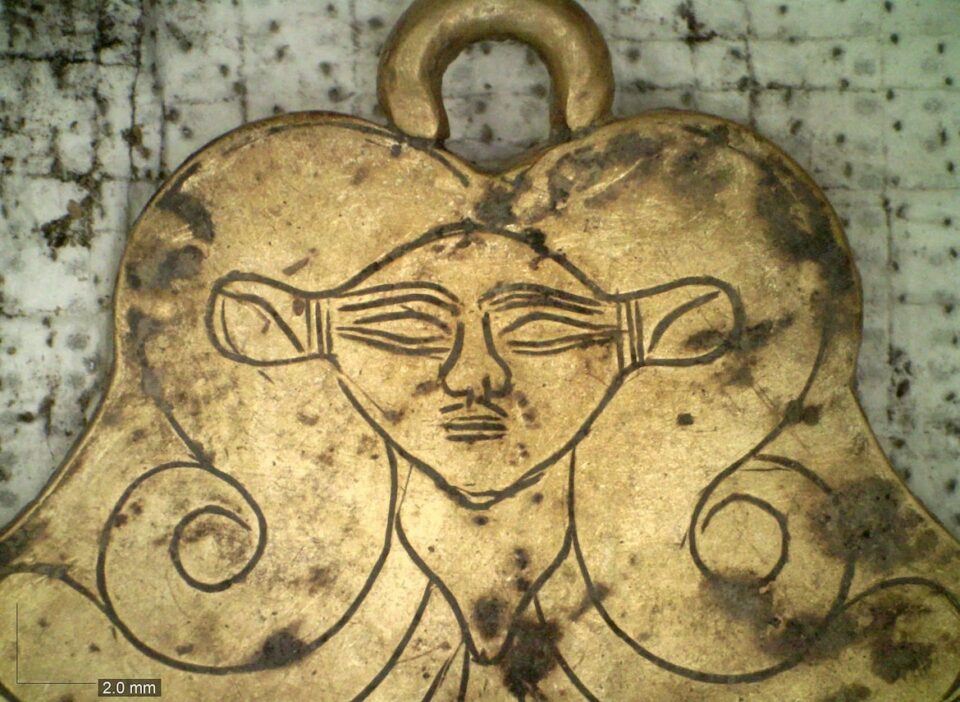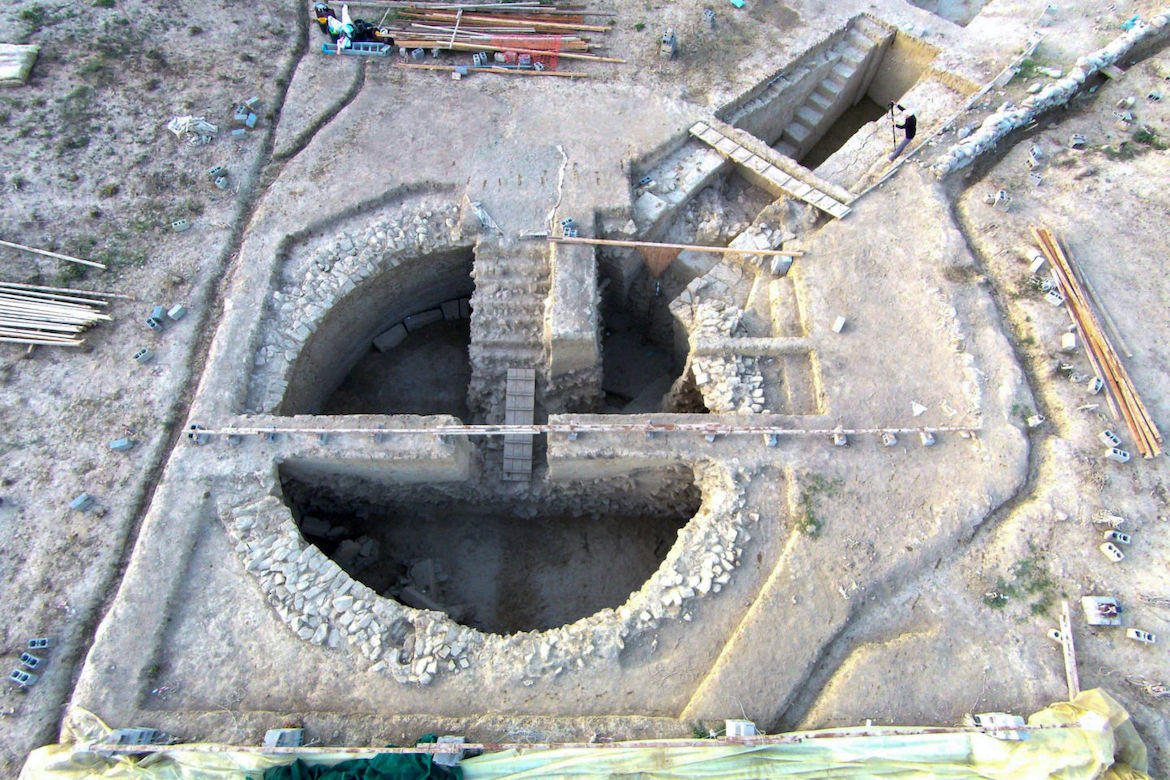Archaeologists with the University of Cincinnati have discovered two Bronze Age tombs near Pylos in the southern Peloponnesos, containing a trove of engraved jewelry and artifacts that promise to unlock secrets about life in ancient Greece.
The UC archaeologists announced the discovery in Greece and news quickly spread throughout the world of this massive archaeological find.
Despite their looting in antiquity by tomb robbers, a treasure trove of items were found, including thousands of pieces of gold foil, remnants of the sheets of gold that once lined the tomb floors.
The larger of the two tombs is 39 feet in diameter and the smaller 28 feet. Both were originally built in a beehive shape known as a tholos but had collapsed.
Archaeologists also found beads made of amber, carnelian and malachite, and a golden pendant depicting the head of the Egyptian goddess Hathor.

(Credit / Vanessa Muros, via the Department of Classics, University of Cincinnati).
These items suggest that Pylos, a city with a fine port, had trading connections, previously unknown, with Egypt and the Near East around 1500 B.C.E., the time the tombs were in use.
The two new tholos tombs were discovered by Jack L. Davis and Sharon R. Stocker, a husband and wife team of archaeologists at the University of Cincinnati who have been working at the site since 1992.
In 2015 they discovered a spectacular shaft grave just outside the ancient palace of Pylos. The grave’s occupant was buried with a long bronze sword and a wealth of Minoan artwork, principally seal stones, of the highest quality. They named him informally as the Griffin Warrior, after a mythical beast carved on an ivory plaque in the grave.

UC’s team spent more than 18 months excavating and documenting the find. “Like with the Griffin Warrior grave, by the end of the first week we knew we had something that was really important,” said Stocker, who supervised the excavation.
“It soon became clear to us that lightning had struck again,” said Davis, head of UC’s classics department.
Artifacts found in the princely tombs tell similar stories about life along the Mediterranean 3,500 years ago, Davis said. A gold ring depicted two bulls flanked by sheaves of grain, identified as barley by a paleobotanist who consulted on the project.

“It’s an interesting scene of animal husbandry — cattle mixed with grain production. It’s the foundation of agriculture,” Davis said. “As far as we know, it’s the only representation of grain in the art of Crete or Minoan civilization.”
The antiquities provide evidence that coastal Pylos was once an important destination for commerce and trade.
“If you look at a map, Pylos is a remote area now. You have to cross mountains to get here. Until recently, it hasn’t even been on the tourist path,” Stocker said. “But if you’re coming by sea, the location makes more sense. It’s on the way to Italy. What we’re learning is that it’s a much more central and important place on the Bronze Age trade route.”
The princely tombs sit close to the palace of Nestor, a ruler mentioned in Homer’s famous works “The Iliad” and “The Odyssey.” The palace was discovered in 1939 by the late UC Classics professor Carl Blegen. Blegen had wanted to excavate in the 1950s in the field where Davis and Stocker found the new tombs but could not get permission from the property owner to expand his investigation.
The tombs would have to wait 63 years for another UC team to make the startling discovery hidden beneath its grape vines.
Excavating the site was particularly arduous. With the excavation season looming, delays in procuring the site forced researchers to postpone plans to study the site first with ground-penetrating radar. Instead, Stocker and Davis relied on their experience and intuition to focus on one disturbed area.
“There were noticeable concentrations of rocks on the surface once we got rid of the vegetation,” she said.
Those turned out to be the exposed covers of deep tombs, one plunging nearly 15 feet. The tombs were protected from the elements and potential thieves by an estimated 40,000 stones the size of watermelons.
The boulders had sat undisturbed for millennia where they had fallen when the domes of the tombs collapsed. And now 3,500 years later, UC’s team had to remove each stone individually.
“It was like going back to the Mycenaean Period. They had placed them by hand in the walls of the tombs and we were taking them out by hand,” Stocker said. “It was a lot of work.”
At every step of the excavation, the researchers used photogrammetry and digital mapping to document the location and orientation of objects in the tomb. This is especially valuable because of the great number of artifacts that were recovered, Davis said.
“We can see all levels as we excavated them and relate them one to the other in three dimensions,” he said.
UC’s team will continue working at Pylos for at least the next two years while they and other researchers around the world unravel mysteries contained in the artifacts.
“It has been 50 years since any substantial tombs of this sort have been found at any Bronze Age palatial site. That makes this extraordinary,” Davis said.
Is The Pappas Post worth $5 a month for all of the content you read? On any given month, we publish dozens of articles that educate, inform, entertain, inspire and enrich thousands who read The Pappas Post. I’m asking those who frequent the site to chip in and help keep the quality of our content high — and free. Click here and start your monthly or annual support today. If you choose to pay (a) $5/month or more or (b) $50/year or more then you will be able to browse our site completely ad-free!

Click here if you would like to subscribe to The Pappas Post Weekly News Update
